-
Countries
-
Data and Analysis
-
Special Focus
-
Crisis Responses
Dashboard/Fact Sheet
Color
-
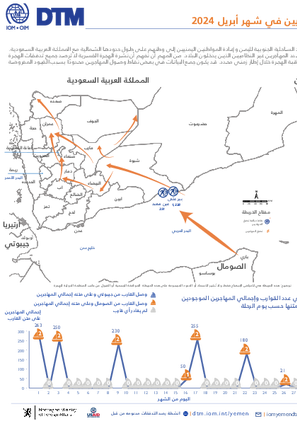
Contact
IOM DTM Yemen, iomyemendtm@iom.int
Language
Arabic
Location
Yemen
Period Covered
Apr 01 2024
Apr 30 2024
Activity
- Flow Monitoring
يراقب سجل مراقبة التدفق (FMR) الخاص بمصفوفة تتبع النزوح في اليمن (DTM) التابعة للمنظمة الدولية للهجرة، وصول المهاجرين على طول الحدود الساحلية الجنوبية لليمن وإعادة المواطنين اليمنيين إلى وطنهم على طول حدودها الشمالية مع المملكة العربية السعودية. يسجل القائمون بالتعداد في نقاط مراقبة التدفق وصول المهاجرين وعودة المواطنين اليمنيين لتحديد أنماط الهجرة المختلفة وتقديم تقديرات كمية لعدد المهاجرين غير النظاميين الذين يدخلون البلاد. من المهم أن نفهم أن نشرة الهجرة القسرية لا ترصد جميع تدفقات الهجرة في اليمن؛ وبدلا من ذلك، فإنه يوفر رؤى إرشادية حول اتجاهات الهجرة استنادا إلى عدد إجمالي غير معروف من المهاجرين الذين يصلون إلى نقاط مراقبة الهجرة خلال إطار زمني محدد. قد يكون جمع البيانات في بعض نقاط وصول المهاجرين محدودًا بسبب القيود المفروضة على الوصول.
في أغسطس 2023، بدأت حملة عسكرية مشتركة للحد من تدفق المهاجرين إلى اليمن، وخاصة أولئك الذين هم في طريقهم إلى المملكة العربية السعودية ودول الخليج الأخرى. استهدفت هذه العملية ساحل محافظة لحج، وهي نقطة دخول رئيسية لعدد كبير من المهاجرين (ما يصل إلى 15,714 مهاجرًا في مارس 2023). واحتجزت القوات العسكرية المهربين وطاردت قواربهم، مما أدى إلى انخفاض تدريجي في تدفق المهاجرين عبر هذا الساحل، والذي توقف تمامًا في نهاية المطاف خلال الأشهر الستة الماضية. كان هناك استثناء واحد في منتصف ديسمبر 2023 عندما أحضر قارب 110 مهاجرين إلى الشاطئ.
في أبريل 2024، أبلغت مصفوفة تتبع النزوح التابعة للمنظمة الدولية للهجرة في اليمن عن دخول 1,479 مهاجرًا إلى اليمن، وهو انخفاض بنسبة 23 بالمائة عن الرقم الإجمالي المُبلغ عنه في الشهر السابق (1,930 مهاجرًا). غادر جميع المهاجرين من منطقة باري في الصومال (1,479) ووصلوا إلى محافظة شبوة في اليمن، والتي عادة ما تكون بمثابة نقطة دخول رئيسية للمهاجرين الذين يغادرون الصومال. علاوة على ذلك، نادراً ما يختار المهاجرون المغادرون من جيبوتي شبوة بسبب المسافة الكبيرة بين الموقعين.
على الرغم من وصول جميع المهاجرين عبر منطقة شبوة الساحلية، إلا أن عدد المهاجرين الذين يدخلون عبر نفس المنطقة انخفض بنسبة 18 في المائة في أبريل (1,479) مقارنة بشهر مارس 2024 (1,800). ومن بين إجمالي المهاجرين المسجلين، كان 22 في المائة أطفال، و15 في المائة نساء، و63 في المائة رجال. ووفقاً للبيانات التي تم جمعها لشهر أبريل 2024، ذكر 74% من المهاجرين أن النزاع كان السبب الرئيسي وراء مغادرتهم بلدهم الأصلي.
حدد فريق مصفوفة تتبع النزوح 5,046 عائداً يمنياً في أبريل 2024، أي بزيادة قدرها 19 بالمائة مقارنة بعدد العائدين في مارس (4,226 فرداً). بالإضافة إلى ذلك، سجل الفريق أيضًا إجمالي 191 مهاجرًا تم ترحيلهم من عمان إلى نقطة ديفين في مديرية شحن بمحافظة المهرة باليمن. وكان جميع المهاجرين المرحلين من عمان مواطنين إثيوبيين.
أجبرت الأزمة الإنسانية المتفاقمة في اليمن العديد من المهاجرين على اتخاذ قرار صعب بالعودة إلى بلدانهم الأصلية في القرن الأفريقي، حيث أفادت التقارير أن السلطات قامت بترحيل بعضهم. في أبريل 2024، سجلت مصفوفة تتبع النزوح ما مجموعه 819 مهاجرًا غادروا اليمن إما طوعًا أو تم ترحيلهم بالقوارب من اليمن. وتتكون هذه المجموعة من 91 في المائة من الرجال، و8 في المائة من النساء، وأقل من 1 في المائة من الأطفال.
علاوة على ذلك، في أبريل 2024، أفاد فريق مصفوفة تتبع النزوح في جيبوتي أن ما مجموعه 631 مهاجرًا (93٪ رجال، 4٪ نساء، و3٪ أطفال) وصلوا إلى جيبوتي قادمين من اليمن بعد القيام برحلة محفوفة بالمخاطر للعودة إلى الوطن. وتؤكد هذه الأرقام التحديات الكبيرة التي يواجهها المهاجرون في اليمن والظروف اليائسة التي دفعتهم إلى المخاطرة برحلات بحرية خطيرة.
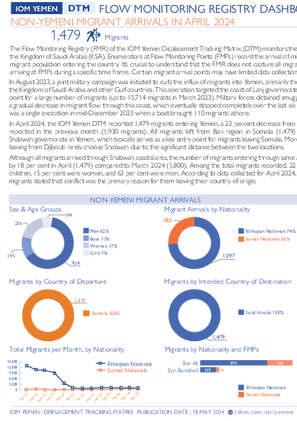
Contact
IOM DTM Yemen, iomyemendtm@iom.int
Language
English
Location
Yemen
Period Covered
Apr 01 2024
Apr 30 2024
Activity
- Flow Monitoring
The Flow Monitoring Registry (FMR) of the IOM Yemen Displacement Tracking Matrix (DTM) monitors the arrival of migrants along Yemen’s southern coastal border and the repatriation of Yemeni nationals along its northern border with the Kingdom of Saudi Arabia (KSA). Enumerators at Flow Monitoring Points (FMPs) record the arrival of migrants and the return of Yemeni nationals to identify various migration patterns and provide quantitative estimates of the irregular migrant population entering the country. It’s crucial to understand that the FMR does not capture all migration flows in Yemen; instead, it provides indicative insights into migration trends based on an unknown total number of migrants arriving at FMPs during a specific time frame. Certain migrant arrival points may have limited data collection due to access constraints.
In August 2023, a joint military campaign was initiated to curb the influx of migrants into Yemen, primarily those en route to the Kingdom of Saudi Arabia and other Gulf countries. This operation targeted the coast of Lahj governorate, a major entry point for a large number of migrants (up to 15,714 migrants in March 2023). Military forces detained smugglers and chased their boats, leading to a gradual decrease in migrant flow through this coast, which eventually stopped completely over the last six months. There was a single exception in mid-December 2023 when a boat brought 110 migrants ashore.
In April 2024, the IOM Yemen DTM reported 1,479 migrants entering Yemen, a 23 percent decrease from the total figure reported in the previous month (1,930 migrants). All migrants left from Bari region in Somalia (1,479) and arrived in Shabwah governorate in Yemen, which typically serves as a key entry point for migrants leaving Somalia. Moreover, migrants leaving from Djibouti rarely choose Shabwah due to the significant distance between the two locations.
Although all migrants arrived through Shabwah coastal area, the number of migrants entering through same area decreased by 18 per cent in April (1,479) compared to March 2024 (1,800). Among the total migrants recorded, 22 per cent were children, 15 per cent were women, and 63 per cent were men. According to data collected for April 2024, 74 per cent of migrants stated that conflict was the primary reason for them leaving their country of origin.
The DTM team identified 5,046 Yemeni returnees in April 2024, a 19 percent increase compared to the number of returnees in March (4,226 individuals). Additionally, the team also recorded total of 191 migrants that were deported from Oman back to Deifen Point in Shahan district of Al Maharah governorate, Yemen. All deported migrants from Oman were Ethiopian nationals.
The worsening humanitarian crisis in Yemen has compelled many migrants to make difficult decision to return to their home countries in the Horn of Africa, some have reportedly been deported by authorities. In April 2024, the DTM recorded a total of 819 migrants leaving Yemen either voluntarily or were deported by boat from Yemen. This group was composed of 91 per cent men, eight per cent women, and less than one per cent children.
Furthermore, in April 2024, the Djibouti DTM team reported a total of 631 migrants (93% men, 4% women, and 3% children) arrived in Djibouti from Yemen after undertaking a perilous journey back home. These figures underscore the significant challenges migrants in Yemen face and the desperate circumstances that have led them to risk dangerous sea voyages.
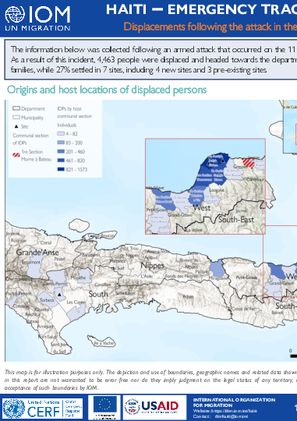
Contact
dtmhaiti@iom.int
Language
English
Location
Haiti
Period Covered
May 11 2024
May 12 2024
Activity
- Mobility Tracking
- Event Tracking
The information below was collected following an armed attack that occurred on the 11 of May 2024 in the municipality of Gressier, specifically in the 1st section of Morne à Bateau. As a result of this incident, 4,463 people were displaced and headed towards the departments of Ouest (92%), Nippes (4%), and Sud (3%). Among them, 73% found refuge with host families, while 27% settled in 7 sites, including 4 new sites and 3 pre-existing sites.
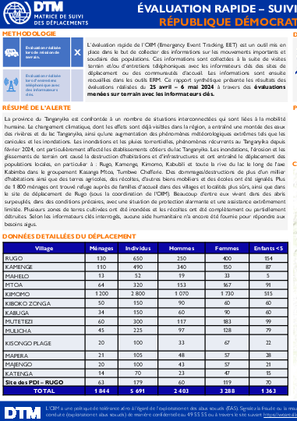
Contact
DTM DRC — iomdrcdtm@iom.int
Language
French
Location
Democratic Republic of the Congo
Period Covered
Apr 25 2024
May 06 2024
Activity
- Mobility Tracking
- Event Tracking
L’évaluation rapide de l’OIM (Emergency Event Tracking, EET) est un outil mis en place dans le but de collecter des informations sur les mouvements importants et soudains des populations. Ces informations sont collectées à la suite de visites terrain et/ou d’entr etiens téléphoniques avec les informateurs clés des sites de déplacement ou des communautés d’accueil. Les informations sont ensuite recueillies dans les outils ERM. Ce rapport synthétique présente les résultats des évaluations réalisées du 25 avril – 6 mai 2024 à travers des évaluations menées sur terrain avec les informateurs clés. La province du Tanganyika est confrontée à un nombre de situations interconnectées qui sont liées à la mobilité humaine. Le changement climatique, dont les effets sont déjà visibles dans la région, a entraîné une montée des eaux des rivières et du lac Tanganyika, ainsi qu'une augmentation des phénomènes météorologiques extrêmes tels que les canicules et les inondations. Les inondations et les pluies torrentielles, phénomènes récurrents au Tanganyika depuis février 2024, ont particulièrement affecté les établissements côtiers du lac Tanganyika. Les inondations, l'érosion et les glissements de terrain ont causé la destruction d'habitations et d'infrastructures et ont entraîné le déplacement des populations locales, en particulier à : Rugo, Kamenge, Kimomo, Kabubili et toute la rive du lac le long de l'axe Kabimba dans le groupement Kasanga Mtoa, Tumbwe Chefferie. Des dommages/destructions de plus d'un millier d'habitations ainsi que des terres agricoles, des récoltes, d'autres biens mobiliers et des écoles ont été signalés. Plus de 1 800 ménages ont trouvé refuge auprès de familles d'accueil dans des villages et localités plus sûrs, ainsi que dans le site de déplacement de Rugo (sous la coordination de l'OIM).

Contact
DTM Nigeria, iomnigeriadtm@iom.int
Language
English
Location
Nigeria
Period Covered
Apr 29 2024
May 05 2024
Activity
- Mobility Tracking
- Event Tracking
Between 29 April and 5 May 2024, a total of 1,005 new arrivals were recorded at locations in Adamawa and Borno states. The new arrivals were recorded at locations in Askira/Uba, Bama, Gubio, Gwoza, Kaga, Kala Balge, Mafa, Monguno and Ngala Local Government Areas (LGAs) of the most conflict-affected Borno State and in Fufore, Gombi, Hong, Lamurde, Madagali, Maiha, Michika, Mubi North, Song, Toungo, Yola North and Yola South LGAs of Adamawa State. ETT assessments identified the following movement triggers: poor living conditions (370 individuals or 37%), seasonal farming (148 individuals or 15%), improved security (144 individuals or 14%), military operations (118 individuals or 12%), family re-unification (90 individuals or 9%), fear of attack (87 individuals or 8%), attack (29 individuals or 3%) and access to humanitarian support (19 individuals or 2%)

Contact
DTMAfghanistan@iom.int
Language
English
Location
Afghanistan
Period Covered
Apr 28 2024
May 04 2024
Activity
- Survey
- Flow Monitoring Survey
- Flow Monitoring
IOM Afghanistan's DTM Flow Monitoring activity, initiated at the beginning of 2024, seeks to quantify and better understand the mobility dynamics at Afghanistan’s borders. On 10 January 2024, DTM began deploying field teams at four border crossing points with the Islamic Republic of Iran (IRN) and Pakistan (PAK), expanding to another border crossing point Ghulam Khan as of 11 February (see map below for the locations of all five crossing points), to conduct two interlinked exercises. The first is a headcount of all individuals entering or leaving Afghanistan (including returnees), also called Flow Monitoring Counting (FMC), to gauge flow volume. The second is a survey of randomly selected Afghan national individuals or groups entering or leaving Afghanistan, also called the Flow Monitoring Survey (FMS), to understand the profiles, motivations, and vulnerabilities of the target population. The inflow from Pakistan increased over the monitoring period. This may be related to media reports and speculation about a potential resumption of the repatriation process, targeting primarily Afghan Citizen Card (ACC) holders, starting from April 15, 2024. However, according to the Pakistani Ministry of Foreign Affairs as of April 26, the repatriation process has not yet begun. Additionally, the Government of Pakistan recently extended the validity of 1.3 million PoR cards for Afghan refugees in Pakistan up to June 30, with their repatriation planned for after the repatriation of ACC holders (Voice of America News). This snapshot provides key findings combining various IOM data sources, including DTM Afghanistan’s FMC and FMS activities, DTM Pakistan’s Flow Monitoring of Afghan returnees, and IOM Afghanistan’s Cross-Border Post-Arrival Humanitarian Assistance (CB-PAHA) program, for the period 28 April to 4 May 2024. For more information about methodology, see the section in the last page of this report titled “IOM INFLOW DATA.”
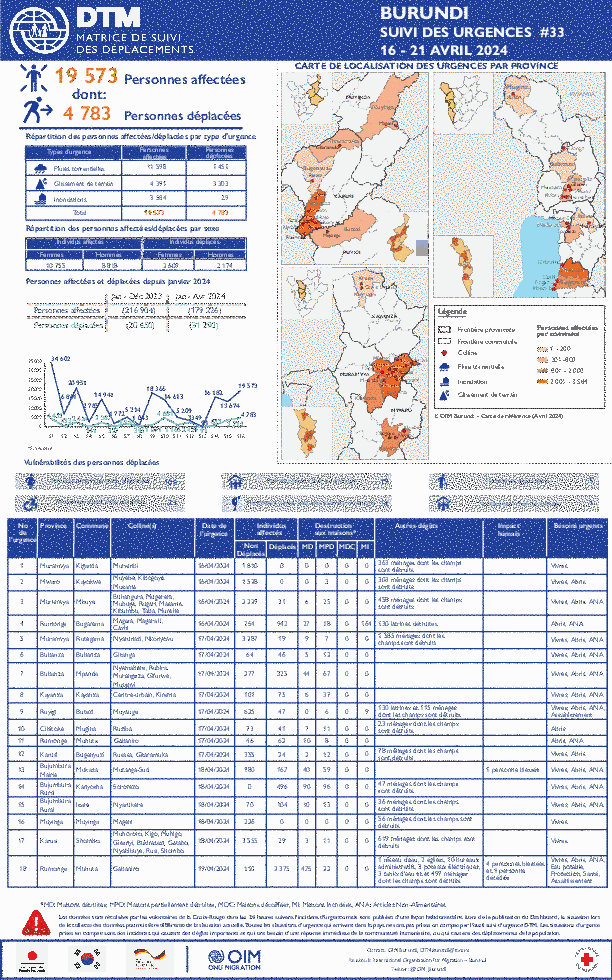
Contact
DTM Burundi, DTMBurundi@iom.int
Language
English
Location
Burundi
Period Covered
Apr 16 2024
Apr 21 2024
Activity
- Mobility Tracking
- Event Tracking
Le rapport DTM indique qu'entre le 16 et le 21 avril 2024, au Burundi, 19 573 personnes ont été affectées et 4 783 déplacées suite à des pluies torrentielles, des glissements de terrain, et des inondations nécessitant une réponse immédiate de la communauté humanitaire. Parmi les affectés, 10 755 sont des femmes et 8 818 sont des hommes.
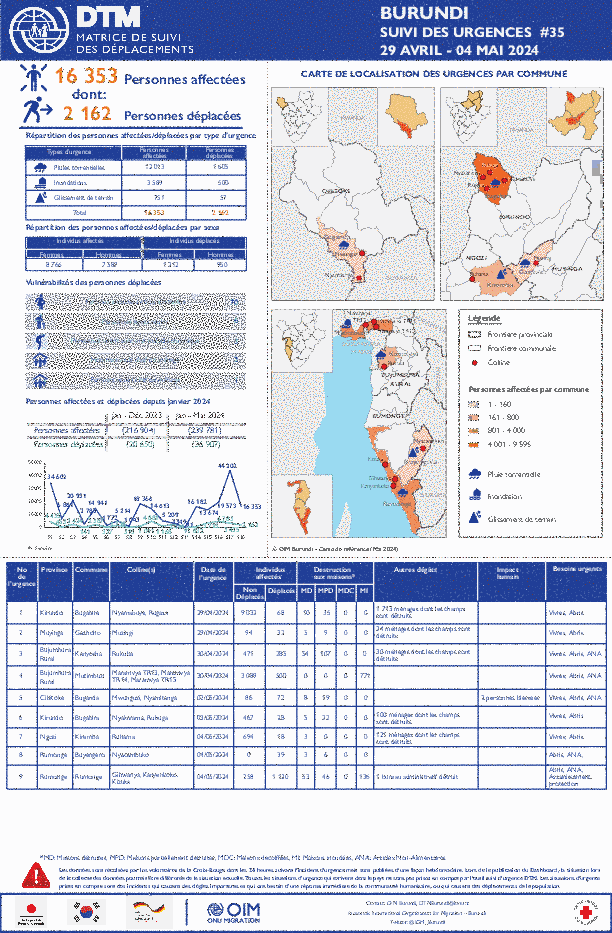
Contact
DTM Burundi, DTMBurundi@iom.int
Language
English
Location
Burundi
Period Covered
Apr 28 2024
May 04 2024
Activity
- Mobility Tracking
- Event Tracking
La DTM Burundi a le plaisir de vous partager (dans le lien ci-dessus) des informations sur les urgences qui se sont produites au Burundi en dates du 29 avril au 04 mai 2024. La DTM a identifié 16 353 personnes affectées (3 170 ménages) dont 2 162 personnes déplacées (405 ménages) par les pluies torrentielles, les inondations et les glissements de terrain dans les provinces de Bujumbura Rural, Cibitoke, Kirundo, Muyinga, Ngozi et Rumonge.

Contact
DTMUkraine@iom.int
Language
English
Location
Ukraine
Period Covered
Feb 01 2024
Mar 15 2024
Activity
- Return Intention
- Mobility Tracking
As of 15 March 2024, IOM estimates that around 3,689,000 people remained internally displaced in Ukraine while UNHCR indicates that further 5,930,400 people were displaced abroad. IOM estimates that, as of 15 March 2024, approximately 4,455,000 people have returned spontaneously to their place of habitual residence in Ukraine following a period of displacement of at least two weeks (internal displacement or cross-border). Of these, 26 per cent have returned from abroad.
To inform targeted interventions aimed at alleviating the vulnerability that stems from poor structural and social conditions in areas of return, the Conditions of Return Assessment (CoRA) provides granular data on where returns are occurring, the ways in which those who have returned are most vulnerable and why.

Contact
DTM Pakistan, DTMPakistan@iom.int
Language
English
Location
Pakistan
Period Covered
Apr 16 2024
Apr 30 2024
Activity
- Flow Monitoring
The International Organization for Migration (IOM) in Pakistan collects data on the outflows of Afghans at the Torkham (Khyber Pakhtunkhwa), Badini, Bahramcha and Chaman (Balochistan) border crossing points (BCPs) to better understand the movements of Afghans returning to Afghanistan. The data presented below is harmonised with those from the United Nations High Commissioner for Refugees (UNHCR), who also cover Ghulam Khan (Khyber Pakhtunkhwa).
On 26 September 2023, the Ministry of Interior in Pakistan announced its decision to enact its “Illegal Foreigners’ Repatriation Plan (IFRP)”. Between 16 and 30 April 2024, 16,547 Afghan nationals returned to Afghanistan, including 9,349 through the Torkham BCP, 6,945 through the Chaman BCP, 253 through the Ghulam Khan BCP, while no Afghan nationals returned through the Badini and Bahramcha BCPs. In addition, border authorities deported 518 individuals due to a lack of valid documentation. Since 1 January 2024, IOM identified 79,624 returns at the four BCPs.
Pagination
- Previous page
- Page 12
- Next page